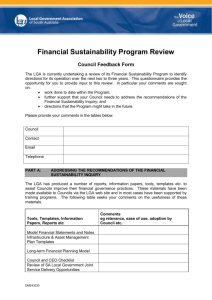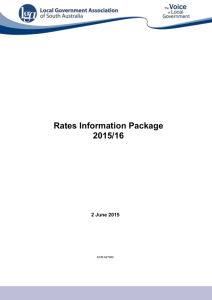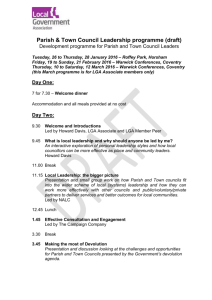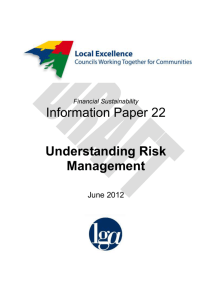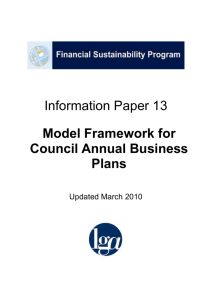LG FS Info Paper 22 - Understanding Risk Management 2015
advertisement
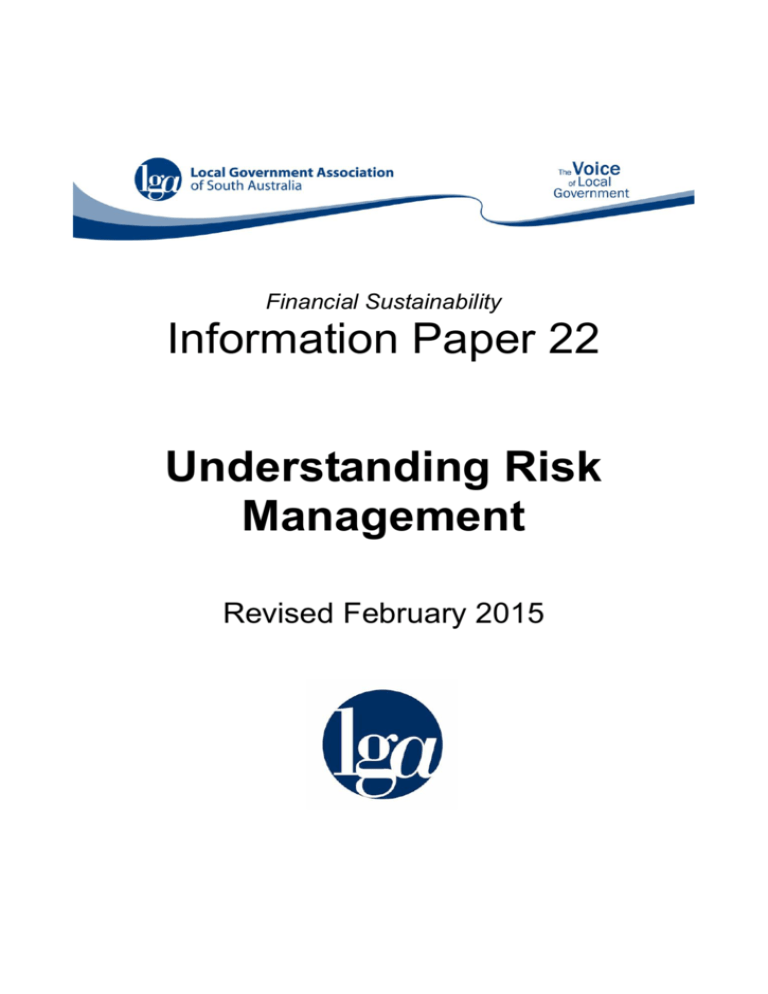
Financial Sustainability Information Paper 22 Understanding Risk Management Revised February 2015 LGA ‘Financial Sustainability’ Information Paper No. 22: Understanding Risk Management – Revised February 2015 Introduction This Information Paper is one of a series of Information Papers about Financial Sustainability and Financial Governance in Local Government. The series of Information Papers was originally published in 2006 to 2011 as a part of the Financial Sustainability Program. The history of that program and a complete list of Information Papers and other resources including a glossary of terms and abbreviations is provided on the LGA’s “Financial Sustainability” web page: www.lga.sa.gov.au/FSP. The entire series of Papers was revised in 2012 and again in early 2015 to take account of legislative changes and other developments. These Papers are addressed to, and written primarily for the benefit of Council Members and staff, but they are also available as a resource for the general public, and students of Local Government. Background The 2005 Independent Inquiry into the Financial Sustainability of Local Government highlighted a need for strengthened policy frameworks and improved financial governance in Local Government. This information paper outlines key steps that a Council should consider when implementing a risk management approach to its services and activities. The paper includes, at Attachment A, an example of a risk management register. This paper should be read in conjunction with other Financial Sustainability Information Papers at www.lga.sa.gov.au/FSP - in particular: Information Paper 21: Internal Financial Controls; Information Paper 23: Financial Governance; and Information Paper 27: Prudential Management. Risk Management – what is it? Risk management is the term applied to a logical and systematic method of establishing the context, identifying, analysing, evaluating, treating, monitoring and communicating risks associated with any activity, function or process in a way that will enable organisations to minimise losses and maximise opportunities. Risk management should be based on the Australian Standard AS/NZS ISO 31 000: Risk Management – Principles and Guidelines (“the Standard”). The Standard defines risk as “the effect of uncertainty on objectives.” Risk management is defined as “co-ordinated activities to direct and control an organisation with regard to risk.” The benefits of a coordinated, systematic approach to risk management include: the Council and its Chief Executive Officer and senior management having a clear understanding of the key risks facing the Council; meeting a Council’s strategic objectives; encouraging proactive management of strategies to identify and manage risks; promoting a positive risk management culture integrated across the Council structure; ensuring a continuous improvement regime across the Council; establishing an effective method for decision making and planning; cost savings that are achieved for Council through the presence of an efficient controls environment; and the community having increased confidence in the Council’s operations. ECM 617337 LGA Financial Sustainability Program – www.lga.sa.gov.au/fsp Page 2 LGA ‘Financial Sustainability’ Information Paper No. 22: Understanding Risk Management – Revised February 2015 The purpose of risk management is not to eliminate all risks but, rather, to reduce them to a level acceptable to the Council in accordance with its risk tolerance limits. Risk management requires a mature proactive approach to management and achieving a balance between the costs of managing risks and the anticipated benefits. Councils are encouraged to adopt and maintain robust risk management, based on the approach outlined in this paper. What does legislation require? There is no legislative provision that specifically requires Councils to implement risk management. However there are references within the Local Government Act 1999 (“the Act”) that require Councils to adopt appropriate policies, practices and procedures that ensure their assets are protected through sound administrative management. In addition, each Council’s Audit Committee is responsible for „reviewing the adequacy of accounting, internal control, reporting and other financial management systems and practices of the Council on a regular basis‟ 1 Each Council auditor is also required to provide an opinion about the adequacy of a Council’s internal financial controls.2 Local Government also has risk management obligations under other legislation, such as the: Work Health and Safety Act 2012 Environment Protection Act 1993; Development Act 1993; South Australian Public Health Act 2011; Food Act 2001; Emergency Management Act 2004; and the Fire and Emergency Services Act 2005, among others. Sound risk management also contributes towards improving Local Government financial sustainability and financial governance. Risk management – the Standard Risk management requires more than simply adopting policy. It requires embedding risk management into every aspect of the Council’s operations, as illustrated by the diagram on page 4 of this Paper. The risk management approach outlined in this Paper is consistent with the Standard which sets out risk management: 1. principles; 2. framework; and 3. processes. 1 2 Section 126(4) of the Act. Section 129(3) of the Act ECM 617337 LGA Financial Sustainability Program – www.lga.sa.gov.au/FSP Page 3 LGA ‘Financial Sustainability’ Information Paper No. 22: Understanding Risk Management – Revised February 2015 AS/NZS ISO 31 000: 2009: RISK MANAGEMENT – PRINCIPLES AND GUIDELINES Defining Risk Management ECM 617337 LGA Financial Sustainability Program – www.lga.sa.gov.au/fsp Page 4 LGA ‘Financial Sustainability’ Information Paper No. 22: Understanding Risk Management – Revised February 2015 1. Principles The principles of risk management, as outlined in the Standard, are: a) b) c) d) e) f) g) h) i) j) k) Creates value Integral part of organisational processes Part of decision-making Explicitly addresses uncertainty Systematic, structured and timely Based on the best available information Tailored Takes human and cultural factors into account Transparent and inclusive Dynjamic, iterative and responsive to change; and Facilitates continual improvement and enhancement of the organisation. 2. The Framework The framework for risk management creates the environment in which risk management processes operate. As outlined in the second panel of the above diagram, there are five elements to a risk management framework. These are: 2 (a) Mandate and commitment Effective risk management requires a strong and sustained commitment by the Council’s leadership, i.e. the elected members, as well as by senior management. If the Council leadership has endorsed a risk management framework, then staff throughout the Council organisation can then rely upon this endorsement as they incorporate risk management processes into their day-today activities. 2 (b) Design of a framework for managing risk Risk management is not something that can be purchased off the shelf. A framework has to be woven into the culture of an organisation, just as a frame is part of the construction of a building. A framework that is designed to be effective within a commercial organisation is unlikely to be suitable for Local Government, which has different responsibilities and needs. Risk management needs will vary between Councils, too, according to the range of services that the Council chooses to provide. The factors that need to be taken into account, in designing a risk management framework include: Understanding the organisation and its context; Establishing a risk management policy and processes; Determining accountability (who is responsible for what?); Integrating risk management into organisational processes, within resources; and Including internal and external communication and reporting mechanisms. Councils seeking practical help with designing a risk management framework should contact the Local Government Mutual Liability Scheme. 2 (c) Implementation of risk management framework (including management process) This is the heart of risk management, and will be discussed in Section 3 below. ECM 617337 LGA Financial Sustainability Program – www.lga.sa.gov.au/fsp the risk Page 5 LGA ‘Financial Sustainability’ Information Paper No. 22: Understanding Risk Management – Revised February 2015 2 (d) Monitoring and review of the framework Effective risk management requires two types of monitoring and review. The actual process of managing risks on a day-to-day basis requires monitoring and review (see Section 3 (e) below). In addition, at the strategic level, the entire risk management framework also requires periodic monitoring and review. At this level, the key tasks are to: measure a Council’s risk management performance against indicators (which should also be periodically reviewed for appropriateness); and determine whether the Council needs to adjust its policies, plans, workforce training or other factors in response to changes in the internal or external environment. Councils seeking practical help with monitoring and reviewing their risk management framework should contact the Local Government Mutual Liability Scheme. 2 (e) Continual improvement of the framework Decisions on improving the Council’s risk management framework should arise from the monitoring and review described above. This will help to nurture the risk management culture within the Council. 3. The risk management process At the heart of risk management are the actual day-to-day processes of risk management, outlined in the third panel of the diagram on page 4: 3(a) Establishing the context of risks 3 (a) (i) External context 3 (a) (ii) Internal context 3 (a) (iii) Risk management policy 3 (b) Risk Assessment 3 (b) (i) Risk identification 3 (b) (ii) Risk analysis 3 (b) (iii) Risk evaluation 3 (c) Risk Treatment 3 (d) Communication and consultation 3 (e) Monitoring and review. Each of these items are discussed below. 3 (a) Establishing the Context of risks The general context in which the Council operates must be taken into account in designing the overall risk management framework. (See section 2(b) above.) However, the context for various Council services and projects may vary. Hence the risks may vary. Examining the context relevant to each Council service, and each project helps to identify, analyse and evaluate risks. 3 (a) (i) External Context The external environment in which the Council seeks to deliver a service or achieve an objective might include, for example, cultural, social, political, legal and financial factors and trends. 3 (a) (ii) Internal Context The internal environment of the Council includes its strategic management plan, governance arrangements, any relevant policies and responsibilities of key staff, etc. For example, most Councils are well aware of what constitutes occupational health and safety risks, and management systems have been in place for many years to ensure these are managed and minimised. ECM 617337 LGA Financial Sustainability Program – www.lga.sa.gov.au/FSP Page 6 LGA ‘Financial Sustainability’ Information Paper No. 22: Understanding Risk Management – Revised February 2015 3 (a) (iii) A risk management policy The Council may wish to establish a formal risk management policy, to express its values, and the overall objectives of its risk management. Such a policy might include, for example: an expression of the Council’s commitment to a risk management framework consistent with the Standard; (or some other commitment); how the Council estimates the likelihood and consequences of risks; and the level at which risk becomes acceptable or tolerable. A Council seeking practical help with drafting a risk management policy should contact the Local Government Mutual Liability Scheme. 3 (b) Risk Assessment Risk assessment is the overall process of risk identification, risk analysis and risk evaluation. 3 (b) (i) Risk identification The Standard defines risk identification as the process of finding, recognising and describing risks. It is about identifying sources of risk, areas of impact, events, opportunities, failure to innovate and their causes and potential consequences. Risk identification needs to be undertaken on a periodic basis, and also in the context of any proposed new service or project.3 The Council should maintain a list or register of risks, and schedule regular reviews of the risk register.4 These reviews should take account of changes in the Council’s services and operating environment and identify all risks that impact on the Council’s activities, regardless of whether or not the risks are under the Council’s control. Approaches used to identify risks may include: Brainstorming sessions; Review of audit findings; Assessment of historical incident data; Assessment of third party contracts; Ongoing project management; and Stakeholder needs In order to ensure comprehensive identification of all relevant risks (where these risks lie within the Council) and the formulation of appropriate treatment plans, risks should be grouped into broad categories along the lines of the following: Asset management Business development Compliance & Legal Financial Governance Human resources Safety & Welfare Information services Procurement Project management Strategic management Environment Public relations See also Local Government Financial Sustainability Information Paper No. 27 – Prudential Management at www.lga.sa.gov.au/FSP 4 See the risk register template at Attachment A. 3 ECM 617337 LGA Financial Sustainability Program – www.lga.sa.gov.au/FSP Page 7 LGA ‘Financial Sustainability’ Information Paper No. 22: Understanding Risk Management – Revised February 2015 3 (b) (ii) Risk analysis Risk analysis is the process to comprehend the nature of risk and to determine the level of risk. The analysis is based on an assessment of the: risk likelihood (the chance of something happening ) and risk consequence (the outcome of an event). The following tables can be used to estimate risk likelihood and risk consequence, to determine an overall risk rating. RISK LIKELIHOOD Level Descriptor Description Expected to occur at times of normal operations (more than once per year) A Almost Certain B Likely C Possible Not expected to occur but could under specific circumstances D Unlikely E Rare Conceivable but not likely to occur under normal operations – no previous occurrence Only occurs in exceptional circumstances Will occur at some stage based on previous incidents RISK CONSEQUENCE Level Descriptor 5 Insignificant 4 Minor 3 Moderate 2 Major 1 Catastrophic Description Negligible Financial Loss, No Injury/First Aid only, no impact to customers/business Minor Financial Loss, Minor Medical attention, Minor interruption to a service with minimal impact Moderate Financial Loss, Significant Injury requiring medical attention, Moderate Interruption to service delivery Major Financial Loss, Serious Long Term Injury. Temporary disablement, Major interruption to service delivery Significant Financial Loss, Major Injury/disablement or death, Major interruption to delivery of all or most services Once the likelihood and consequence have been assessed for a particular risk the overall inherent risk can be determined by referring to a risk priority matrix, like this one: ECM 617337 LGA Financial Sustainability Program – www.lga.sa.gov.au/FSP Page 8 LGA ‘Financial Sustainability’ Information Paper No. 22: Understanding Risk Management – Revised February 2015 3 (b) (iii) Risk evaluation The purpose of risk evaluation is to make decisions about which risks need treatment and the treatment priorities. It should be obvious that risks analysed as “extreme” would warrant correspondingly diligent risk management treatment, while risks analysed as “low” would warrant less attention. Not all risks will necessarily warrant any risk treatment. Some “low” risks may disregarded, if the risk involved is regarded as tolerable, although all risks should be re-evaluated from time to time to ascertain whether the analysis rating is still correct. The Council is unlikely to have sufficient resources to treat all risks in an optimum manner. Therefore it will always be necessary to evaluate and prioritise: which risks to treat, or mitigate; and the resources (if any) to devote to treating or mitigating each risk. Council’s evaluation of risks must be documented. This is a safeguard for Council in the event that its risk management may be called into question as part of a claim for compensation (e.g. if an injured person alleges Council negligence in dealing with a risk). The elements that may be taken into consideration when assessing controls and mitigating factors associated with a particular risk include: Legal requirements relevant to the risk; Council’s risk management policy, if any (see 3(a)(iii) above); Design of facilities; Cost of alterations; Communication of risk factors (e.g. warning signs) Risk borne by parties other than the Council; Defined responsibilities and accountabilities; Monitoring and review procedures. 3 (c) Risk treatment The Standard defines Risk treatment as the process to modify risk. Therefore, risk treatment involves selecting one or more options for modifying each risk. Accordingly, risk treatment can involve one or more of options such as: avoiding the risk; pursuing the risk as an opportunity; removing the risk source; changing the likelihood; changing the consequences; sharing the risk with other parties; and/or retaining the risk. Appropriate treatment plans will vary with circumstances, but should be developed to be consistent with Councils’: strategic management plans; long-term financial plan; infrastructure and asset management plan; policies (perhaps reflecting Council concerns about non-financial matters such as social or environmental goals); and annual budget. ECM 617337 LGA Financial Sustainability Program – www.lga.sa.gov.au/FSP Page 9 LGA ‘Financial Sustainability’ Information Paper No. 22: Understanding Risk Management – Revised February 2015 After an inherent risk has been modified, it may still exist in a different form (perhaps because the likelihood has been changed, or the consequences have been changed). What remains is described as the residual risk. Good treatment plans should include the following elements: Specific actions; Resourcing; Delegations; Timing; Definition of key performance indicators; and Communication, feedback and control. 3 (d) Communication and Consultation Communication and consultation are important during each step of risk management. Whether they realise it or not, all staff members play a role in risk management. Communication is not a one-way activity. Staff suggestions, ideas and co-operation should be sought for all stages of the risk management process described above, especially identifying risks and proposing risk treatments. Communication and consultation is also necessary with external stakeholders (e.g. any organisations partnering with Council during projects). If all staff and external stakeholders understand the basis on which risk management decisions are made and why particular actions are required, this will help to ensure that the Council’s risk management is fully informed at all stages. 3 (e) Monitor and Review A Council’s risk management is not a static policy or one-off procedure, but must be part of ongoing business. A Council, its management team, and Audit Committee, must set aside time to periodically review both the framework under which risks are managed (see section 2 above) and also the process of risk management (section 3). Regular reporting, checking or surveillance and review against key criteria will ensure that treatment plans, if any, are achieving their aim and remain relevant. It will also serve to highlight changes in risk analysis ratings, and identify any new risks, arising from a changed internal or external context. Responsibilities for monitoring and reviewing should be clearly defined, as part of the risk management framework. Councils should ensure that their risk management systems are supported by a structured process to record relevant information including: risks identified, analyses and assessments, treatment options and methodologies, decision processes and treatment performance results. Good corporate governance dictates that this risk management information is captured and retained throughout the risk management cycle. An example of a basic Risk Register is included as Attachment A. ECM 617337 LGA Financial Sustainability Program – www.lga.sa.gov.au/FSP Page 10 LGA ‘Financial Sustainability’ Information Paper No. 22: Understanding Risk Management – Revised February 2015 Issues for Councils The management of risk is a fundamental component of achieving financial sustainability and underpins Councils’ capacity and resilience in achieving all its strategic and operational objectives. Councils should develop and adopt an organisation-wide risk management framework, and processes, as described above, consistent with the Australian Standard AS/NZS ISO 31 000: Risk Management – Principles and Guidelines. This would include ongoing procedures to monitor, review and update risk management activities to maintain continuous improvement. A Council’s Audit Committee should play a key role in ensuring that this occurs. It is important however to emphasise that the adoption of such a framework and processes will not lead to the elimination of risks. Rather, it will lead to the management of these risks in a cost-effective and strategic manner that supports good governance principles. A Council seeking practical help with any of the above should contact the Local Government Mutual Liability Scheme. Acknowledgements Development of this paper has benefited from contributions by Mark Jeffreson of UHY Haines Norton and funding from the Local Government Research and Development Scheme. ECM 617337 LGA Financial Sustainability Program – www.lga.sa.gov.au/FSP Page 11 Attachment A Risk Register Risk ECM 617337 Risk Description Current Controls Likelihood Consequence and/or mitigating factors Chance of something happening Outcome of an event LGA Financial Sustainability Program – www.lga.sa.gov.au/fsp Page 12 Level of Risk (rated) eg Risk Priority Rating Treatment Strategy/ies
